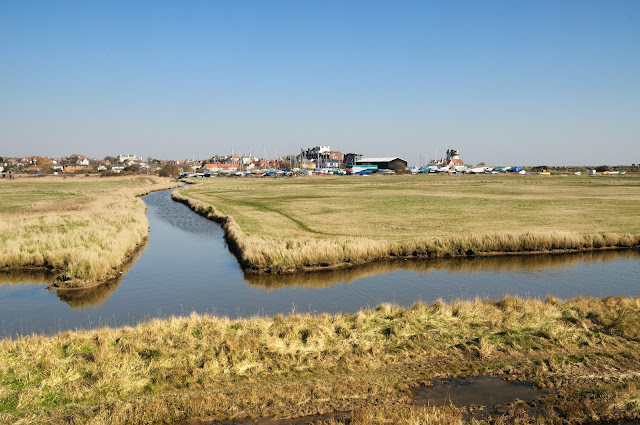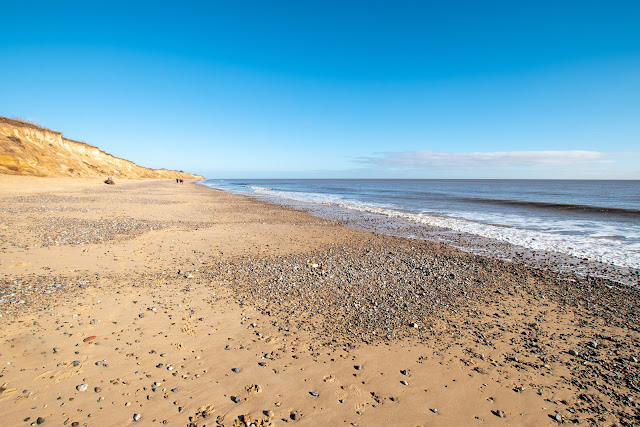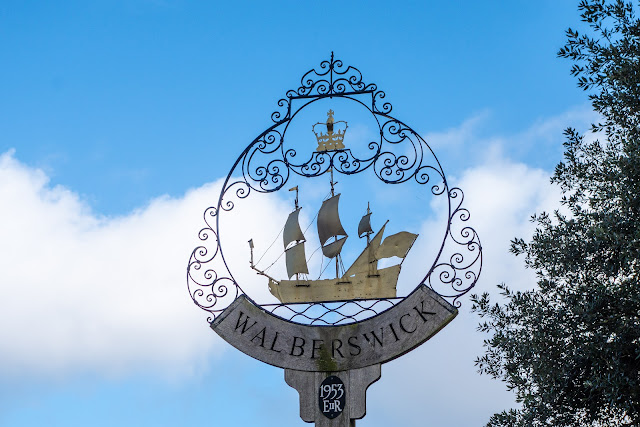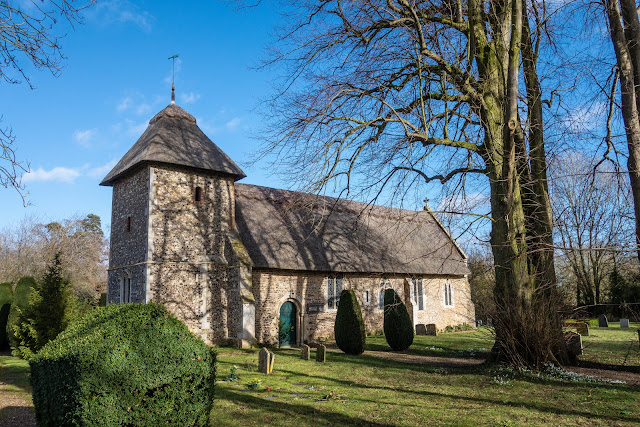Aldeburgh is one of my favourite seaside town as it has many varied things to see, apart from beach and sea! These range from Maggi Hambling’s The Scallop, to a lighthouse in the town and a great Moot Hall. So, on another glorious day, we started our tour with a walk along by the river, and then explored the town. I must confess that some of the images were from a previous visit!
With your back to the river, this is your view of the town, as you start the riverside walk. Very pleasant too, with many birds (if you are lucky)
Fort Green Mill is a tower mill at which has been converted to residential accommodation, and was built in 1824. It was converted into a house in 1902.It was a four storey tower mill and had four patent sails and the domed cap was winded by a fantail. It had two pairs of millstones. Earlier photographs of the working mill shows that the sails were double patents carried on a cast iron wind shaft and the fantail had six blades.
The lookout
Copied from "Visit Suffolk" - The bonds between Aldeburgh, art, and the sea have always been strong ones. The Aldeburgh coastline has captured the hearts of many artists through the centuries, and when international art dealer Caroline Wiseman first set eyes on the dramatic landscape, she too found herself entranced by its siren call.Caroline has spent over 25 years working in the art world and has established successful open-house galleries in New York, London and Aldeburgh. She bought the Lookout, an extraordinary nineteenth century tower on the seafront, which came with a home on Crag Path adjacent, on the proviso that it must be used for artistic purposes.
Benjamin Britten also famously did much of his composing on Aldeburgh beach. Citing artists’ retreat the Lightning Field in New Mexico as her inspiration, Caroline set about turning the Lookout into a place where both established and exciting up-and-coming artists could come and be seized by that same magic.
Since 2011 Caroline has been offering week-long residencies at the Lookout, the rules of which are simple; firstly the artist must create new work over the course of the week, and secondly they must spend one full night in the tower.
What a great idea!
The Old Custom House, listed as 1703, has a fascinating raised front door but no-one is able to explain why. The two big ground-floor windows seem out of scale and were a late addition.
Not sure of this cottage, but just loved the look.
Perhaps one of the smallest houses you’ll ever see, right on the seafront in Aldeburgh, in the car park behind 152 High Street, is this tiny building. Consisting of a kitchen, a bedroom and a bathroom, the house is the width of one parking space. Recently, a walled garden was added, taking the width of an adjacent car park.
The Scallop, this iconic image of the Suffolk Coast arrived on Aldeburgh beach in 2003, courtesy of local artist, Maggi Hambling. The sculpture was set up to commemorate Benjamin Britten and displays a quote from Britten’s Peter Grimes ‘I hear those voices that will not be drowned’.
Hambling, who was brought up in Hadleigh, Suffolk, first studied at the East Anglian School of Painting and Drawing 1962-4 and then at the Ipswich School of Art before moving to London where she would soon achieve worldwide acclaim.
The quote from Britten’s Peter Grimes ‘I hear those voices that will not be drowned’.
Yes, it can be windy on the beach!
Moot Hall, the well known, timbered frame building near Aldeburgh seafront. It was built sometime during the early 16th century as a Council Chamber and Market Cross. Later, it was named Moot Hall, and the tall chimneys were added.
Originally, it opened on to the town market - the arcade of four arches on the ground floor were filled in with brick by the Victorians, but would have originally been open, with space for market stalls beneath, as well as a pair of prison cells! When the infamous Witch finder General, Matthew Hopkins, was hired by the burgesses of Aldeburgh to search the town in 1646, six local women were found guilty and held in the cells at the hall until they ‘confessed’ to their crimes. They were hanged on specially constructed gallows. The houses between the marketplace and the shore have long since been swept into the sea.Today, Moot Hall is home to Aldeburgh Museum.
The Church of St Peter and St Paul, Aldeburgh.
There was a church here at the time of the Domesday Book, but the current church of St Peter and St Paul is largely an early 16th-century building, with an earlier 14th-century tower. There may have been an even earlier Saxon church at Aldeburgh, but if so, only limited traces of that building now remains in the altered roof line of the current church.
As mentioned, the tower is the oldest part of the church, and it is such a notable local landmark hat it was used for many years by mariners to pilot their ships.
Internally, the oldest feature of the church is the font, which dates to around 1320. You can see that several of the carved panels have been defaced; this destruction took place in 1643 when a local man named Thomas Johnson aided the famed iconoclast William Dowsing in destroying '20 cherubim and 38 pictures' as well as taking a sword to the carvings on the font.
Johnson is buried in the floor before the altar - a strange honour perhaps, for a man who destroyed much historic architecture at Aldeburgh, but such was life during the Reformation!
Before Johnson and Dowsing were active, the church was the scene of a much happier event. In 1573 a group of travelling actors gave a performance here. The troupe was known as the Earl of Leicester's Men, and they would later count among their number a certain young actor and playwright called William Shakespeare
The south porch adjoins the pavement, and has arches in its east and west walls to allow processions to pass within the precincts of the graveyard. This was built by the Holy Trinity gild, right on the eve of the Reformation.
The very well-preserved oaken parish chest
The Benjamin Britten memorial window
It is by the artist John Piper, in stained glass, and shows images from three of his church parables: The Prodigal Son, Curlew River, and The Burning Fiery Furnace. It sits in the north aisle, and gets enough light to fill the aisle with colour.


































































